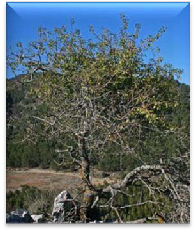Also Known as: rock cherry, amarel, St. Lucie cherry, perfumed cherry, little leafed mahaleb
Mahaleb cherry (Prunus mahaleb L) is native to parts of Europe, Asia, and Africa. It is a deciduous tree or large shrub, typically growing 20 to 30 feet tall. Mahaleb is deep-rooted, with a fibrous root system. The bark is grey-brown. Slender  branches angle sharply out and upward, radiating from the main stem in a spoke-like fashion, with conspicuous distances between branch “spokes.” The leaves are small, simple, irregular, ovate to cordate, serrated, glabrous and green. Petioles are with or without glands. Flowering occurs in mid-spring. The flowers are white and arranged in an umbel-like short raceme; they are hermaphrodite (having both male and female organs) and are pollinated by insects. The fruit is a small, thin-fleshed, spherical drupe that changes in color as it ripens from green to red, dark purple and finally black, fully maturing in mid to late summer. The seed of the plant is commonly spread by birds. The seed kernel has a strong bitter taste (not unlike bitter almonds) that, in parts of the Mediterranean, is dried, ground and used as a spice in breads and pastries. As a safety precaution, one should never eat bitter seeds or fruits as they often contain toxins. The genus prunus is known to produce hydrogen cyanide, a poisonous compound that―in small amounts― can stimulate respiration and improve digestion. The bark, wood, and seeds of Mahaleb cherry contain coumarin, which reportedly has anti-inflammatory effects.
branches angle sharply out and upward, radiating from the main stem in a spoke-like fashion, with conspicuous distances between branch “spokes.” The leaves are small, simple, irregular, ovate to cordate, serrated, glabrous and green. Petioles are with or without glands. Flowering occurs in mid-spring. The flowers are white and arranged in an umbel-like short raceme; they are hermaphrodite (having both male and female organs) and are pollinated by insects. The fruit is a small, thin-fleshed, spherical drupe that changes in color as it ripens from green to red, dark purple and finally black, fully maturing in mid to late summer. The seed of the plant is commonly spread by birds. The seed kernel has a strong bitter taste (not unlike bitter almonds) that, in parts of the Mediterranean, is dried, ground and used as a spice in breads and pastries. As a safety precaution, one should never eat bitter seeds or fruits as they often contain toxins. The genus prunus is known to produce hydrogen cyanide, a poisonous compound that―in small amounts― can stimulate respiration and improve digestion. The bark, wood, and seeds of Mahaleb cherry contain coumarin, which reportedly has anti-inflammatory effects.
Although tolerant of soil conditions, mahaleb cherry thrives in well-drained, moisture-retentive soil. It is drought resistant and can grow in nutritionally poor soil. It grows in full sun or partial shade and can be found in light woodland areas, draws and north-side hills.
Because mahaleb cherry is fairly robust, winter hardy and disease-resistant, it has been popular in the United States as rootstock for cultivated sweet and sour cherries, although its use has diminished because of its appeal to gophers.
The Pacific Northwest Exotic Pest Plant Council and other similar groups have determined that mahaleb cherry is of ecological concern and planting should be restricted, although the Corfin Center for Biodiversity of the University of Wisconsin describes it as a “cultivated alien species that rarely escapes.”
Control Methods
Little information is available about mahaleb cherry control since it is not widely recognized as an invasive plant. Small trees can be dug out. For larger trees/shrubs, the cut-stump method would be more appropriate. This method is carried out by cutting the main stem as close to the ground as possible and quickly applying an appropriate chemical to the severed stump. Contact your extension agent for more information.
More information can be found in the PNW Weed Management Handbook
USE PESTICIDES WITH CARE. Apply them only to plants, animals, or sites listed on the label. When mixing and applying pesticides, follow all label precautions to protect yourself and others around you. It is a violation of the law to disregard label directions. Store pesticides in their original containers and keep them out of the reach of children, pets, and livestock.
Questions: contact Steve Van Vleet or phone (509) 397 – 6290
Photo credits included in PDF





